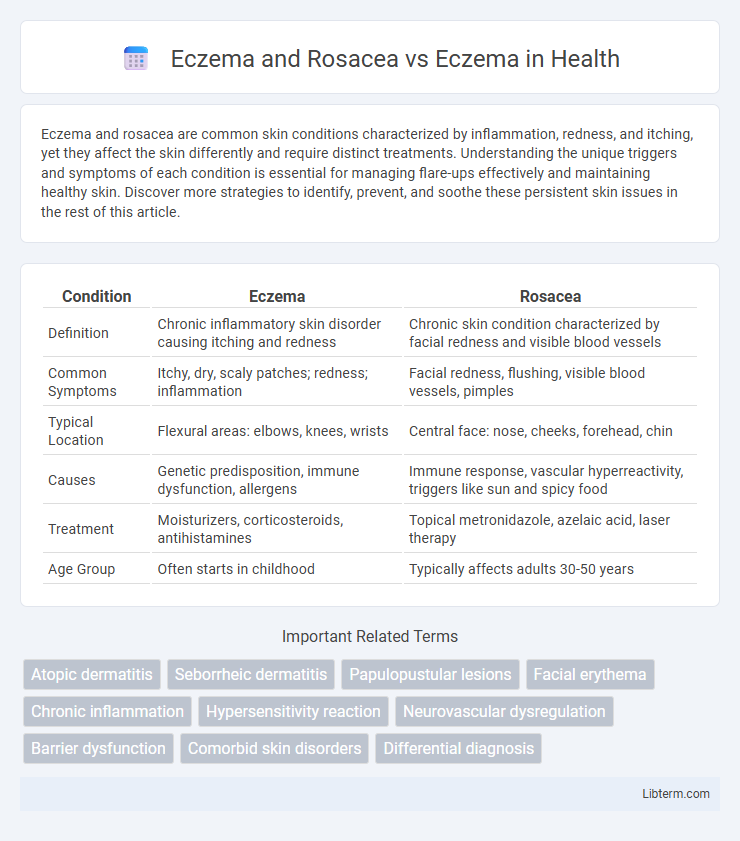Eczema and rosacea are common skin conditions characterized by inflammation, redness, and itching, yet they affect the skin differently and require distinct treatments. Understanding the unique triggers and symptoms of each condition is essential for managing flare-ups effectively and maintaining healthy skin. Discover more strategies to identify, prevent, and soothe these persistent skin issues in the rest of this article.
Table of Comparison
| Condition | Eczema | Rosacea |
|---|---|---|
| Definition | Chronic inflammatory skin disorder causing itching and redness | Chronic skin condition characterized by facial redness and visible blood vessels |
| Common Symptoms | Itchy, dry, scaly patches; redness; inflammation | Facial redness, flushing, visible blood vessels, pimples |
| Typical Location | Flexural areas: elbows, knees, wrists | Central face: nose, cheeks, forehead, chin |
| Causes | Genetic predisposition, immune dysfunction, allergens | Immune response, vascular hyperreactivity, triggers like sun and spicy food |
| Treatment | Moisturizers, corticosteroids, antihistamines | Topical metronidazole, azelaic acid, laser therapy |
| Age Group | Often starts in childhood | Typically affects adults 30-50 years |
Understanding Eczema: Causes and Symptoms
Eczema is a chronic skin condition characterized by inflammation, itching, and redness, primarily caused by genetic factors, immune system dysfunction, and environmental triggers such as allergens and irritants. Unlike rosacea, which presents with persistent facial redness, visible blood vessels, and acne-like bumps, eczema can affect various body areas and is marked by dry, scaly patches that may weep or crust. Recognizing the distinctions in symptoms and triggers between eczema and rosacea is essential for targeted treatment and effective management of each condition.
What is Rosacea? Key Features and Triggers
Rosacea is a chronic inflammatory skin condition primarily affecting the central face, characterized by persistent redness, visible blood vessels, and sometimes acne-like bumps, which distinguishes it from eczema that mainly causes itchy, dry, and scaly patches. Key features of rosacea include facial flushing, papules, pustules, and ocular symptoms such as eye irritation, while eczema involves more widespread inflammation and intense itching. Common triggers for rosacea are sun exposure, spicy foods, alcohol, stress, and temperature extremes, contrasting with eczema triggers such as allergens, irritants, and dry skin.
Eczema vs. Rosacea: How Are They Different?
Eczema and rosacea are both chronic inflammatory skin conditions but differ significantly in symptoms and affected areas. Eczema primarily causes itchy, dry, and scaly patches often found on flexural areas like elbows and knees, whereas rosacea manifests as persistent facial redness, visible blood vessels, and sometimes acne-like bumps predominantly on the cheeks, nose, and forehead. Understanding these differences is crucial for accurate diagnosis and targeted treatment, as eczema responds well to moisturizers and corticosteroids, while rosacea treatment focuses on reducing inflammation and avoiding triggers like sun exposure and spicy foods.
Overlapping Symptoms: Eczema with Rosacea
Eczema with rosacea presents overlapping symptoms such as redness, inflammation, and itchiness, making diagnosis challenging. Both conditions often cause dry, sensitive skin and flare-ups triggered by environmental factors or irritants. Distinguishing these symptoms is crucial for effective treatment since rosacea primarily affects the central face while eczema can appear on various body parts.
Diagnosing Eczema and Rosacea: Key Considerations
Diagnosing eczema and rosacea requires careful evaluation of symptoms, as eczema typically presents with itchy, inflamed patches of dry skin while rosacea is characterized by facial redness, visible blood vessels, and sometimes acne-like bumps. Key considerations include assessing the distribution of lesions--eczema often affects flexural areas like elbows and knees, whereas rosacea primarily targets the central face. Accurate diagnosis may involve skin biopsy and patient history to differentiate these conditions and guide appropriate treatment plans.
Common Triggers for Eczema and Rosacea
Common triggers for eczema include allergens like dust mites, pet dander, and certain foods, as well as irritants such as soaps, detergents, and extreme temperatures. Rosacea triggers often involve environmental factors like sun exposure, hot or cold weather, spicy foods, and stress. Both conditions may worsen with alcohol consumption and emotional stress, but the specific irritants and inflammatory responses differ significantly.
Treatment Options: Eczema Alone vs. Eczema with Rosacea
Treatment options for eczema alone typically include moisturizing creams, topical corticosteroids, and antihistamines to reduce inflammation and itching. When eczema is combined with rosacea, treatment requires a tailored approach incorporating gentle skin care routines alongside anti-inflammatory medications like metronidazole or azelaic acid, which specifically address rosacea symptoms. Avoiding triggers common to both conditions, such as harsh skincare products and extreme weather, is essential for effective management.
Skincare Tips for Eczema and Rosacea Management
Eczema and rosacea require distinct skincare approaches to minimize irritation and flare-ups, with eczema benefiting from rich moisturizers containing ceramides to restore the skin barrier, while rosacea care emphasizes gentle, fragrance-free cleansers and sunscreen to reduce redness and sensitivity. Avoiding common triggers such as harsh soaps, extreme temperatures, and abrasive exfoliants is crucial for both conditions, as they can exacerbate inflammation and discomfort. Incorporating anti-inflammatory ingredients like niacinamide and using lukewarm water during cleansing supports skin hydration and reduces irritation for effective eczema and rosacea management.
When to See a Dermatologist for Eczema or Rosacea
Seek a dermatologist promptly if eczema symptoms worsen despite home treatment, including severe itching, widespread rash, or signs of infection such as oozing and crusting. Rosacea requires dermatological evaluation when persistent facial redness, visible blood vessels, or acne-like breakouts cause discomfort or affect appearance. Early professional diagnosis and treatment can prevent complications and improve management outcomes for both eczema and rosacea.
Prevention Strategies for Flare-Ups in Eczema and Rosacea
Effective prevention strategies for eczema and rosacea focus on identifying and avoiding triggers such as harsh skincare products, extreme temperatures, and stress. Maintaining a consistent, gentle skincare routine with hypoallergenic moisturizers helps reinforce the skin barrier and reduce flare-ups in both conditions. Regular dermatological consultations enable personalized management plans to minimize inflammation and prevent exacerbations.
Eczema and Rosacea Infographic

 libterm.com
libterm.com